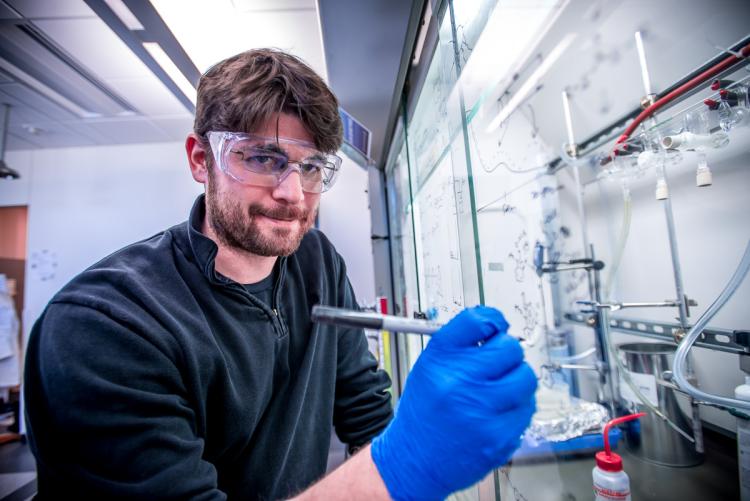

Assistant Professor Andrew Goodwin is hoping to change the way we approach disease diagnosis and management. Below are 10 things you may not know about this researcher who joined the department in August 2012.
- Goodwin’s research focuses on furthering nanomedicine through a combination of chemical design, colloid and surface engineering, and imaging. His group has created the first NIR-sensitive drug delivery vehicle, new polymer coatings for nanomaterials, and the first ultrasound contrast agents that could change their acoustic properties upon sensing their local biochemical environment.
- Why are the colloids and materials Goodwin creates considered “smart”? Because they can sense their surroundings and react by transmitting information, releasing encapsulated contents, or performing other useful functions. Applications for these technologies include drug delivery, imaging, catalysis, sensing, and renewable materials.
- Goodwin received a $2.2M NIH Director’s New Innovator Award for his ultrasound project. This award, given for bold research ideas of unusually broad impact, was the first New Innovator Award won by a CU Boulder faculty member. He has also received an additional $1M in other grants from NIH involving other imaging contrast agents.
- How does Goodwin use commonly-available ultrasound to detect cancer and heart disease? There are many important biomarkers for inflammation, cancer, heart disease, and other common diseases, but their levels are often measured in bulk systemic fluids such as blood, lymph, urine, or saliva. While biomarker levels may be highly overexpressed at the local diseased site, the bulk measurements are subject to dilution, input from other sources, and variation from patient to patient during measurement, leading to considerable diagnostic uncertainty. To solve these issues, Goodwin is developing unique colloidal structures that detect and quantify elevated biomarker levels at localized sites within deep tissue, with a goal to reach clinical trials by 2020. If successful, his methods will represent a quantum leap forward in the tools available for diagnosing disease.
- Goodwin’s group is also investigating how chemical bonds in polymer material behave when stressed and using this information to design more robust or even self-healing polymer materials.
- Why nanomedicine? “My undergraduate research was in a traditional organic chemical synthesis lab,” he says. “While I enjoyed making molecules, I saw others designing macromolecules that could perform specific functions in the lab. From this, my goal became to try to make polymers perform desired tasks but in very restricted environments, like deep inside the body, which led to the near infrared drug delivery vehicles.”
- In the three years he has been with the department, Goodwin has published 11 peer-reviewed manuscripts in high-impact journals, filed two patent disclosures, given 14 invited presentations, and chaired national meeting symposia for the ACS and AIChE.
- Goodwin would like to see future cancer research tackle metastases. “Most patients who succumb to cancer die not from the initial (primary) tumor but from the metastases that may eventually appear in the lungs, brain, bone, and liver,” he says. “What if new chemotherapeutic techniques were developed that seek out the small metastases as they form and destroy them before they become dangerous? This would hopefully allow cancer to become a disease that can be managed with minimal side effects, like diabetes, rather than a disease with high mortality.”
- Ranging from the sophomore-level gateway course Materials and Energy Balances to a graduate elective in Colloid and Interface Science, Goodwin’s teaching portfolio is diverse. “My favorite part of teaching is getting to know the students in class and being able to work one-on-one to help them learn the material,” he says.
- Like many Boulder residents, Goodwin likes food, dogs, and going to the gym.
